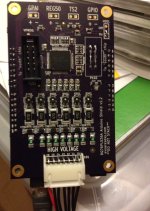dmwahl said:
The main thing I'll need help with is firmware, there was someone helping me with that a while ago and he had a good start, but I haven't been able to get in touch with him so it's back to the start. I have all the basics worked out, but need someone with the ability to create a complete firmware. I plan on offering the board to anyone who can help with software at cost.
Um... sorry Dave, that would likely be me. Tried to call ya just now, what can I say things have been F*C&ED up here for me for a while but I'm happy to rewrite the firmware for 12-24S stackable using the BQ76PL536A and Arduino. I did finish mucking about with the developer board (3 in stack config) and a bit more playing about but for the "paying" project I had been working on (before falling into the abyss) I actually worked it out in a similar fashion to Fetcher/Gary Goodrum TL431 chip style with a single ATTiny marshalling every 2 cells and feeding a master BMS Arduino1280 as the "MCU Brain". This was not so much a better design electronically but conformed to the clients specifications and even supported HOT SWAP of their 2S{X}P blocks which they chose to go with (each 2S had its own slaver unit).
To be perfectly honest I had quoted them a great price for the R&D, PCB Design and Firmware which was around 3500 USD (I know cheap labor but we had common goals I thought). Worst part is, when I completed the job and produced 12 working prototypes (24S 80AH 30/40C Lipo worth) the customer had me assemble the first test pack and then never bothered to even pay the balance of 3K (I only charged 500 upfront for cost of materials). Adding insult to injury, I found out about 4 months ago, they knocked my design and my firmware off (I set the lock bits but it's a damn close knock off) and are now mass producing (or having them produced in mass) in fricking China. Since they are not a 100% copy and they are actually not a US company but rather a Chinese company who fronted via a Delaware USA corporation... I really have no recourse.
Before you ask (any of you, not just dave)... The design while function is far from efficient as it's design intent was modular and hot swappable, something we don't care for... not to mention the parts cost, BOM, surface mount (except the bleeders) assembly difficulty (me and average joe) and finally... while it would serve the client right if I dumped all publically, I won't stoop to their level nor drop IMHO total crap on the market or even the ES DIY crowd.
That said... I am available to write up the firmware / adapt the old firmware (nah I'll start from scratch, I've come along way) but I would like to discuss some hardware stuffs with you - if not included in the basic Arduino BMS offering then at least plug and play via headers to enhance functionality.
Give me a call when you have time, you have the number

Regards,
Mike aka mwkeefer


